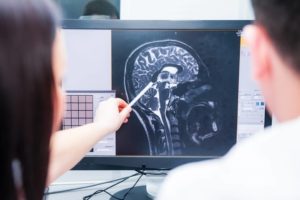Brain Cancer Treatment Options
 At Sunridge, we approach brain cancer with aggressive treatments that increase the natural response of the body’s immune system to fight the cancer and tumors, while crossing the blood-brain barrier. Continued studies and new evidence show that targeting cancer with tumor-specific antigens may just be the most effective way to treat cancer without toxicity. These types of therapies, introduced systemically into the body, successfully localize to the cancerous tumors in the central nervous system, inducing the good cells or (T-Cells) to destroy the cancer without side effects or damage to the surrounding tissue.
At Sunridge, we approach brain cancer with aggressive treatments that increase the natural response of the body’s immune system to fight the cancer and tumors, while crossing the blood-brain barrier. Continued studies and new evidence show that targeting cancer with tumor-specific antigens may just be the most effective way to treat cancer without toxicity. These types of therapies, introduced systemically into the body, successfully localize to the cancerous tumors in the central nervous system, inducing the good cells or (T-Cells) to destroy the cancer without side effects or damage to the surrounding tissue.
Revolutionizing Alternative Brain Cancer Treatment
Brain Cancer Treatment Options
Hear From Our Patients
The Sunridge Approach to Brain Cancer
At Sunridge Medical we offer a comprehensive immunobiological treatment aimed at attacking the cancer, and restoring the body’s natural defense and regulatory mechanisms, including the immune system and detoxification pathways. Our approach combines alternative and conventional therapies to provide patients with the most overall comprehensive Brain cancer treatment. Because successful cancer treatment is not a “one size fits all” approach, substantial time is spent with each patient to learn more about the details surrounding their illness as this is a necessary component to developing the right treatment. Cancer cells develop in every human being.
Brain Cancer – A Second Opinion
Naturopathic Oncology and Integrative Oncology
Understanding Brain Cancer
The Cancer Cell in Brain Cancer
A Weakened Immune System and Cell Production
Circulating Tumor Cells
Stopping the Glucose Game
Standard of Care for Brain Cancer
The Effects of Chemotherapy vs. Natural Chemicals in Brain Cancer
What Is Brain Cancer?
The following symptoms are most common:
- Weakness
- Clumsiness
- Difficulty Walking
- Seizures
Other nonspecific symptoms and signs include the following:
- Altered mental status — changes in concentration, alertness, attention, or memory
- Vomiting, Nausea, — particularly early in the morning
- Difficulty with speech
- Abnormalities in vision
- Gradual changes in intellectual or emotional capacity
See your health care provider right away if you have any of the following symptoms:
- Unexplained, persistent vomiting
- Unexplained blurring of vision, especially one side
- Lethargy or increased sleepiness
- Seizures
- New type of headaches
References for Brain Cancer
For answers and to make an appointment, call toll-free 800-923-7878 to speak with our Patient Care Team.
Recover your vitality, reclaim your energy and rediscover your health.


